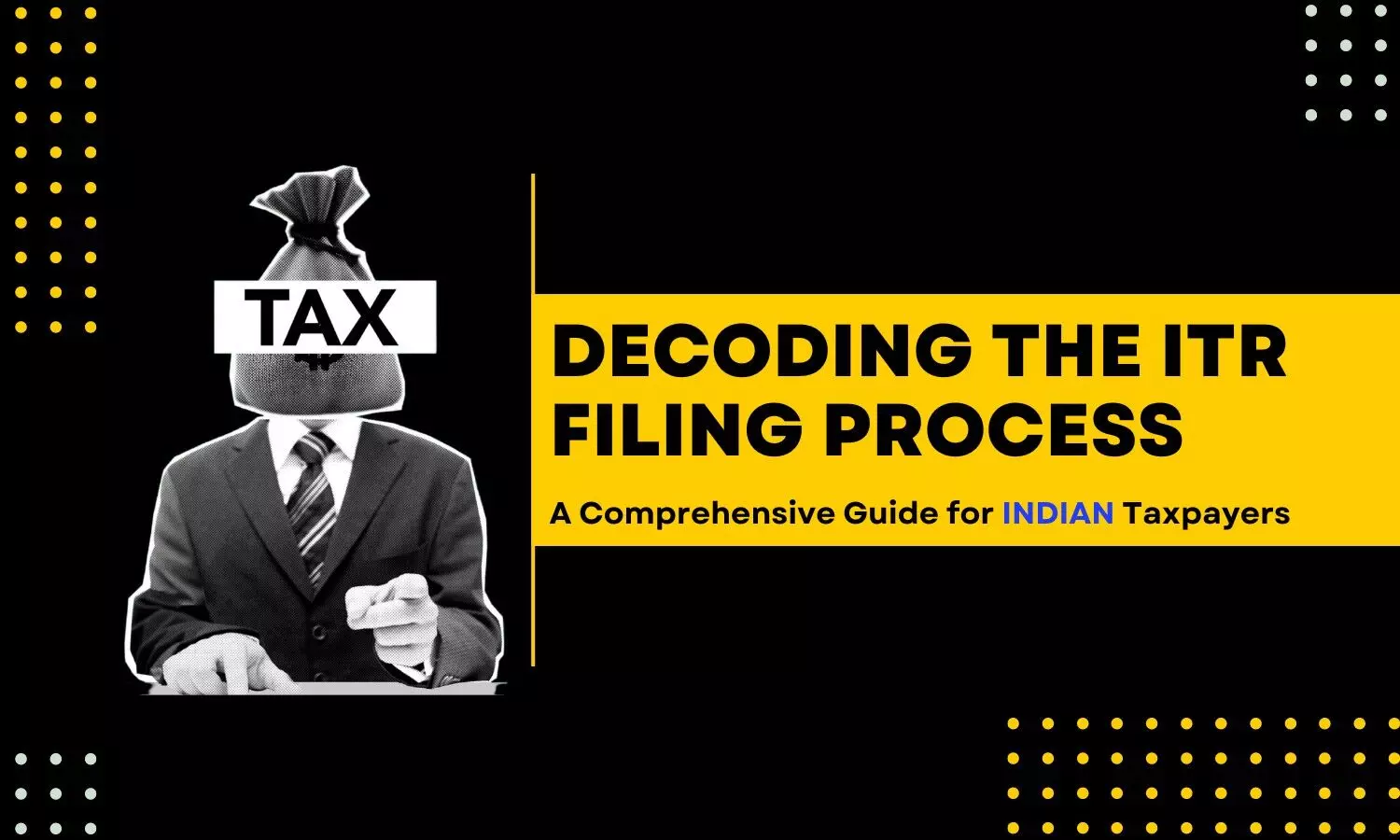Decoding the ITR Filing Process: A Comprehensive Guide for Indian Taxpayers
Filing income tax returns (ITR) is an essential responsibility for every Indian taxpayer.

Decoding the ITR Filing Process
Introduction
Filing income tax returns (ITR) is an essential responsibility for every Indian taxpayer.It is a legal requirement that helps the government assess an individual's income and tax liabilities. However, understanding the ITR filing process can be daunting, especially for those unfamiliar with tax regulations. This comprehensive guide will decode the ITR filing process, providing step-by-step instructions to make it easier for Indian taxpayers.
Steps for ITR Filing Process
ITR tax filing is a complex process with grievous penalties if one does it wrong. Look at the steps to ensure you don't miss anything.
Step 1: Determine the Appropriate ITR Form
Choose the right ITR form for submitting your taxes. Income sources and categories determine the income tax department's forms. People, HUFs, and corporations have many forms. To choose an ITR form, contact the income tax department's website or a tax specialist.
Step 2: Gather the Required Documents
Before initiating the ITR filing process, gather all the necessary documents. This includes your PAN card, Aadhaar card, bank statements, Form 16 or 16A (if applicable), investment and loan details, and any other relevant financial documents. Ensure you have accurate and up-to-date information to avoid errors during the ITR tax filing process.
Step 3: Calculate Total Income and Tax Liability
Combining wages, company earnings, rental income, and capital gains yields your annual income. Deduct exemptions, deductions, and allowances to calculate taxable income. Calculate the tax due using the income tax slabs and rates for the financial year. The income tax department's website lists these slabs and rates.
Step 4: Fill in the ITR Form
Complete the income tax return filing once you have the necessary documents and have calculated your total income and tax liability. Enter accurate details in the relevant sections of the form, including personal information, income details, tax deductions, and exemptions claimed. Double-check the information to avoid errors leading to penalties or additional scrutiny.
Step 5: Verify the ITR Form
Verify all ITR form data. Complete, accurate, and match all fields. The income tax agency accepts net banking EVCs, Aadhaar OTPs, and signed physical copies sent to the Centralized Processing Center (CPC).
Step 6: Submit the ITR Form
Once the form is verified, submit it through the income tax department's official website. The department provides an online portal for e-filing, making the process quick and convenient. Upload the verified ITR form and follow the instructions on the website to complete the submission.
Step 7: Acknowledgment and Verification
The income tax agency will acknowledge your ITR submission. Save this acknowledgment. Electronic verification sends the acknowledgment to your email address. If you provide a hard copy, the acknowledgment will be mailed.
Step 8: Respond to Any Notice, if Required
In some circumstances, the income tax agency may request more information. Review such notification and react within the given timeframe. To comply with department regulations, get expert help. Indian taxpayers may confidently file ITRs by following these step-by-step guidelines. Checking the income tax department's website or consulting tax specialists is recommended to stay current on tax rules and regulations.
Important Points for a Smooth Filing Process
- Deadline: The due date for income tax return filing varies each year, so it is crucial to know the current year's deadline. Failing to file within the stipulated time may result in penalties and interest.
- Digital Signature: If you opt for the digital signature method for verification, ensure that you have a valid digital signature certificate (DSC) issued by a recognized certifying authority.
- Pre-validate Bank Account: If you are eligible for a tax refund, it is advisable to pre-validate your bank account details on the income tax department's portal. This enables direct credit of refunds, reducing the processing time.
- Maintain Proper Records: Recording income, spending, investments, and deductions is crucial. These documents will aid in filing and verification.
- File Revised Returns, if necessary: If you notice a mistake or omission after submitting your ITR, you can file an amended return within the deadline. If you submitted the initial return on time, this option is accessible.
- Seek Professional Assistance: Consult an online tax consultant if you have a complicated financial position or find ITR filing difficult. They can advise you, optimize your tax liabilities, and assure tax law compliance.
Conclusion
Understanding the ITR filing process is essential for every Indian taxpayer. You can fulfill your tax obligations efficiently by following the step-by-step instructions outlined in this comprehensive guide, gathering the required documents, and accurately filling in the ITR form. Remember to stay updated on any changes in tax regulations and seek professional assistance when needed. Filing your ITR on time and accurately not only ensures compliance but also contributes to the smooth functioning of the country's tax system.
If you're still unsure about filing your Income Tax Return (ITR) and need guidance on how to do it, click here, and you're all set to file your Income Tax Return (ITR). We've got you covered with a simple and comprehensive guide to help you through the process. Start now and ensure a hassle-free filing experience!
Important Links
Law Library: Notes and Study Material for LLB, LLM, Judiciary, and Entrance Exams

